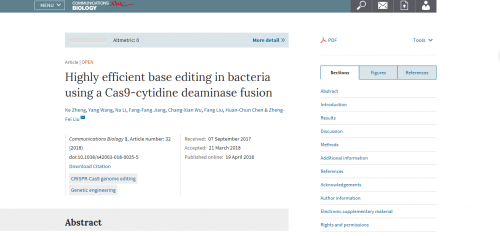
On April 19th, the paper Highly efficient base editing in bacteria using a Cas9-cytidine deaminase fusion,with Ph.D candidate Zheng Ke as the first author and Prof. Liu Zhengfei the corresponding author, was published in Communications Biology, a new journal of Nature, marking the new achievement scored in single base editing of prokaryotes by Prof. Liu’s research group at College of Animal Sciences and Technology|College of Veterinary Medicine of HZAU.
Gene editing is an effective means of studying gene function. Despite the remarkable progress in the gene editing of eukaryotes thanks to CRISPR technology, the genetic manipulation of prokaryotes is still a problem bewildering the scientists. Only after two rounds of two-step homologous recombination can the target gene be deleted in the classical bacterial gene editing method with extremely low occurrence rate in each round (10-6~10-4). In the relatively highly-efficient (10-3~10-1) lambda red recombination system, however, it is required that the bacteria be transformed in advance to guarantee a stable editing efficiency.
The single base editing technology of prokaryotes proposed by Prof Liu's team is characterized by rapidity, accuracy, high efficiency and wide applicability. Based on the CRISPR/Cas9 system, the technology can lead to the premature termination of the target gene by converting the cytosine (C) targeted to the DNA site to thymine (T)(using Cas9 protein to guide cytosine deaminase) and then by mutating CAA, CAG, CGA and TGG codons to TAA, TAG and TGA stop codons, thereby inactivating the gene. With an editing efficiency of 99.93%, the technology can be applied to varieties of bacteria and used as a fast and efficient tool for gene editing, providing a good technical platform for the progress in study of prokaryotic gene function.
It is reported that Prof. Liu's team, dedicated to the study of animal infectious diseases and zoonotic diseases, has made notable achievements in the neurotropiam and latent infections of the α herpes virus, as well as the intracellular parasitism and pathogenic mechanisms of Brucella.
论文链接:https://www.nature.com/articles/s42003-018-0035-5
Paper links: https://www.nature.com/articles/s42003-018-0035-5
Translator: Wu Zhijia; Instructor: Xie Lujie
http://news.hzau.edu.cn/2018/0423/51809.shtml
